Hearing protection is critical for shooters doing live-fire training. Shooters exposed to excessive noise will have hearing loss, similar to workers in noisy environments. Appropriate ear protection reduces the noise to safe levels. For instance, exposure to an intense sound like a gunshot — that’s 140 dB (decibels) or more — can permanently damage the ear. OSHA and the Centers for Disease Control suggest the safe-exposure limit is 85 dB for eight hours. An example of 85 dB is urban city traffic. Normal conversation is 60 dB, a hair dryer is 90 dB, an MP3 player is 100 dB at full volume, a rock concert is 110 dB, and a chainsaw is about 119 dB. It is generally considered that 120 dB is the pain threshold and the point where ear damage starts. So let’s put decibels into terms we shooters understand. A Daisy Red Ryder BB gun produces 97 dB, a 22 LR rifle is 140 dB, a full-size 9mm produces 162 dB, and an AR-15 rifle in 5.56 NATO produces 165 dB.
There are the low-tech solutions to sound overexposure, such as earplugs, which seal the ear channel if inserted correctly. These do the best job of reducing gun-fire report, and they unfortunately also do a good job of stifling communication between people at the shooting range. I wish I had a dollar for every time I heard shooting partners say, “What? Whadya say?” even when standing next to each other. Our team shooters always have ear plugs on hand when we test because the devices can easily be stored in a range bag and the batteries never run out. But they are not ideal. They are easily dropped and take longer to insert than putting on muffs.
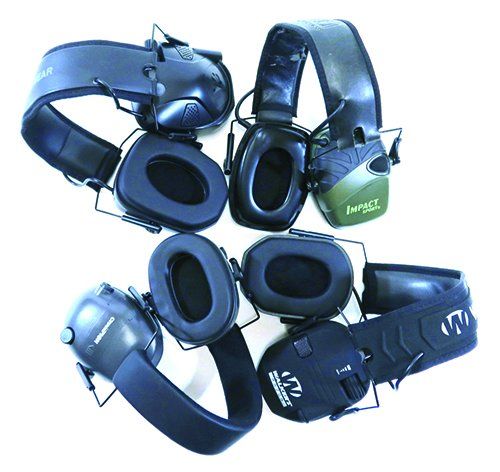
The same is true to a lesser extent with traditional earmuffs, which are also referred to as passive earmuffs. Passive earmuffs use a cushioned cup for each ear with an adjustable band that goes either over the top or behind the user’s head. The good things about passive earmuffs is that they are convenient to put on and take off repeatedly, they are easily paired with earplugs, they are inexpensive, and they can be folded so they are easy to stow, one size usually fits all, and they are durable. No worries if you drop these earmuffs since they can take abuse, and they can be shared in a pinch. The downside of passive earmuffs is they can be bulky, can interfere with proper cheek weld when shooting a long gun, may not seal around the ear when shooting with safety or prescription glasses, they do not provide as much noise reduction as earplugs, and they impede communication with other shooters. Passive earmuffs can also be uncomfortable to wear and some cannot be used with ball caps, and if you have long hair that can be an issue, too. Some of our testers use both earplugs and passive earmuffs when shooting specific firearms.
Electronic earmuffs stifle gun noise yet allow you to communicate without removing ear protection or resorting to yelling. Readers have asked us to review electronic earmuffs, so we assembled a variety of models at different price points from different manufacturers, which included Venture Gear Amp BT ($100 from RAJSupply.com), Walker’s Razor Slim ($70; WalkersGameEar.com), Champion Electronic Ear Muffs ($30; CheaperThanDirt.com), and Howard Leight Impact Sport Earmuff ($60; Cabelas.com).
How does electronic ear protection work? Electronic earmuffs are similar to traditional earmuffs. They use a cushioned cup over the ear to seal out sound, plus they use external microphones and internal speakers to allow users to hear normal conversation or range commands while cutting out loud, harmful sounds like gunfire. Some can also be connected to smart phones via a Bluetooth connection and external audio plugs.
The advantages of electronic ear protection include the ability to filter noise; muffling loud noises but amplifying subtle noises like a deer walking in the woods or conversation with fellow shooters. On the flip side, they are expensive, not necessarily water resistant, and require batteries. Like passive earmuffs, some electronic earmuffs can also be bulky and uncomfortable to wear for extended periods of time.
How We Tested
Prior to range use, we tested the electronic earmuffs with a test offered by the CDC online (CDC.gov/niosh/mining/content/quickfitweb.html). The test allows you to determine if you are getting at least minimal 15 dB level of hearing protection. We tested using the earmuffs turned off and then turned them on and found they all passed the 15 dB test. When turned on, we could also hear the sound. We also tested the muffs at outdoor and indoor ranges firing a 22 LR pistol, compact 9mm pistol, a 357 Magnum revolver, 12-gauge shotgun, and an AR-15 in 5.56 NATO with a 16-inch barrel. We chose a range of firearms so we could get a range of noise from popular firearms as well as cheek welds from long guns. Some also have the ability to help hunters hear game approaching, and these units should be weatherproof.

All muffs tested used either AA or AAA batteries, which are easy to locate and buy. The Walker’s, Venture Gear, and Howard Leight had one battery compartment, the Champion had two.
We looked for noise reduction, clarity of sound, wearing comfort, and ergonomics. We also drop-tested them on a concrete floor to simulate an accidental drop. All passed the drop test. Since each ear on humans is slightly different, we looked at how well the ear cups sealed off the ear from sound. All testers wore prescription glasses or shooting glasses when testing. We found that some eyewear frames can affect the seal of the cups. Some earmuffs have a strong spring in the head band that can be uncomfortable when wearing eye protection. Here’s what we discovered about each unit.
Venture Gear Amp BT, $100
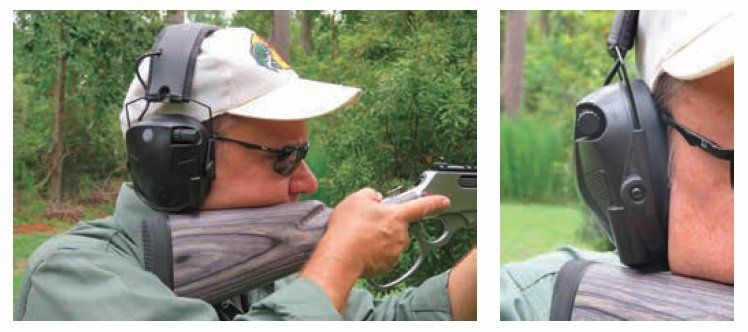
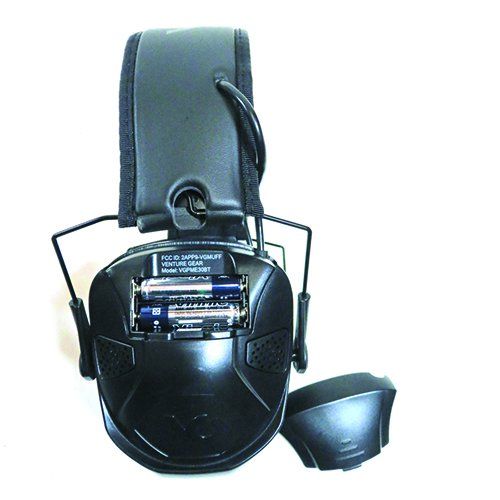
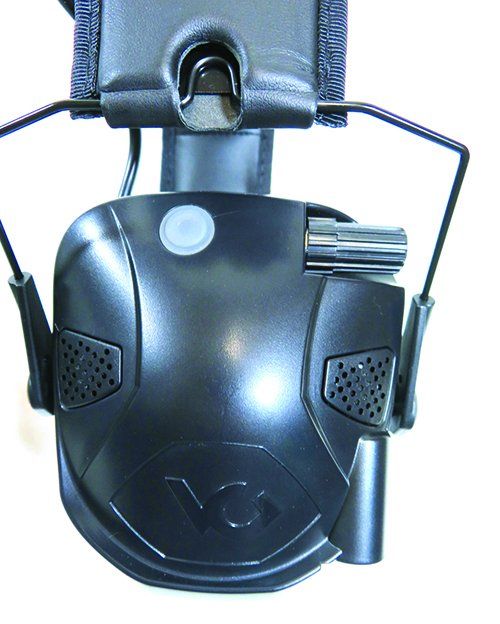
These came from RAJSupply.com. The Amp BT electronic earmuff cups are large and offer a good seal over the ear. Some testers used ear plugs in addition to the Amp BT when shooting AR-15 on indoor ranges. The sound and reverberating concussion inside the indoor ranges means a higher level of ear protection is needed even if the range has sound dampening material in the divider between ranges.
In our opinion, you could have a normal conversation while wearing the Amp BT, which uses four microphones so you can hear what is in front of you and behind you. The on/off knob is large and well textured, so you can turn it on off even when using gloved hands. When you turn the volume on, a start-up tone is played, which is a nice feature. This tells the user the earmuffs are on. Many testers turned on earmuffs but did not hear any sound, so they initially turned up the volume on the earmuffs, only to turn it down because it was too loud. The Amp BT avoids this issue.
We attached our iPhone to the muffs and made a call at the range and could hear clearly. In fact the clarity with this unit was good, with no static. Because the ear cups are so large, they did make contact with the stock on long guns and got in the way of some testers’ cheek welds.
The headband is made of a synthetic material, so it cleans easily and is padded for comfort. It was comfortable to wear and easily adjust. It was easy to access the battery compartment. The auxiliary jack does come with a plug, so there is a chance moisture can get in.
Our Team Said: In our opinion, the Amp BT is a good choice for an all-round earmuff, but it is better suited for pistol shooters because the ear cup could interfere with the stock. We like the auto shutoff. We don’t think there is much value in the smart-phone feature, but it could be valuable for someone who works in loud environment and needs to communicate.
GUN TESTS GRADE: A-
Walker’s Razor Slim, $70
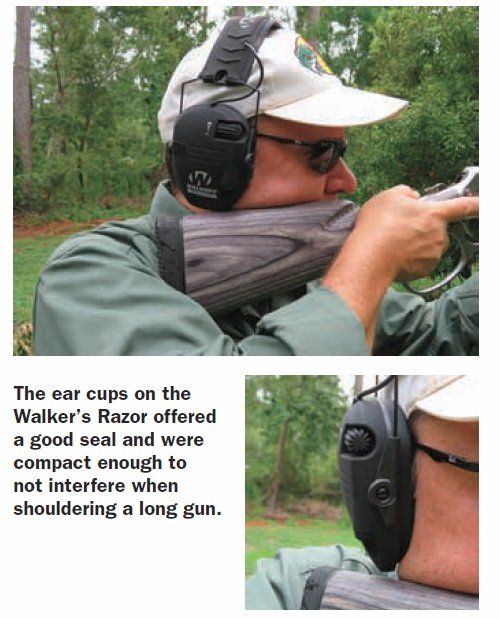
These are available at WalkersGameEar.com. The Walker’s Razor muffs are comfortable to wear, with no C-clamp effect on the head and ear cups that are sized in-between the Venture Gear and Champion units. The outside of the ear cups are also tapered so there is less knocking of the ear cup against the stock when mounting a long gun. The Razor uses two microphones so the headset can be worn with microphones facing front or rear. The volume control is a gnarly knob with excellent serrations that offer great texture when operating with or without gloves. The headband is padded and made of a synthetic material that is easy to wipe clean. The outside of the headband is a cloth material. The battery compartment offers easy access. The auxiliary jack input comes with a rubber plug so there is no chance of moisture getting into the electronics. In our opinion, the Walker’s was the most comfortable to wear of all the units tested. We still used ear plugs with them at the indoor range. We also felt the Razor was more friendly to eyewear and that maybe was due to the soft ear cushions in the cups. There was a slight bit of hiss when we turned the volume high. With the wind blowing a brisk 5 mph during one outdoor range session, we could hear the wind in the microphone. Some of our testers who have used Howard Leight earmuffs for years appreciated the Walker’s Razor design.
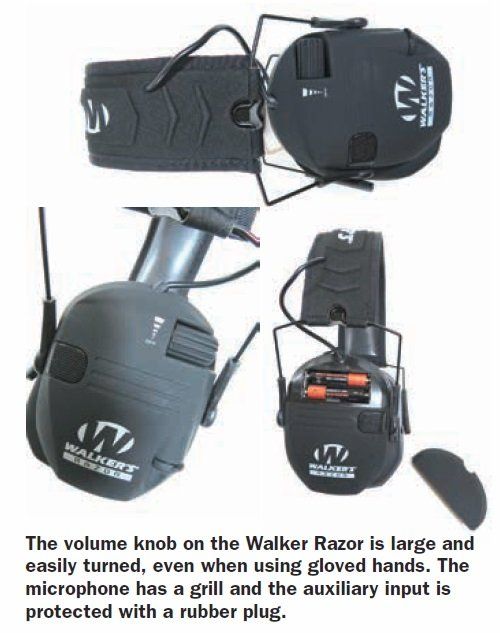
Our Team Said: The Walker’s Razor is well suited for the recreational shooter and hunter. This unit is less bulky than the Venture Gear and the Champion units. We liked the auto shut off on this unit as a measure to prevent battery drain.
GUN TESTS GRADE: A
Howard Leight Impact Sport, $60
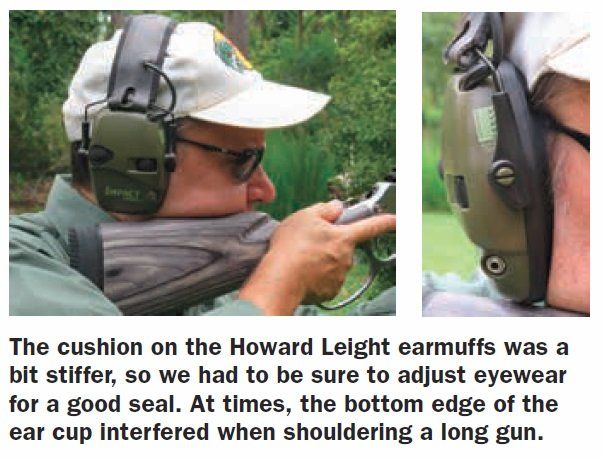
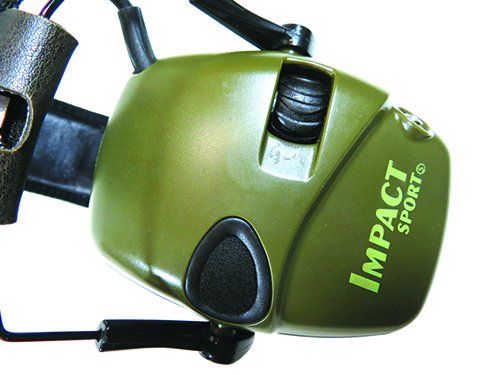
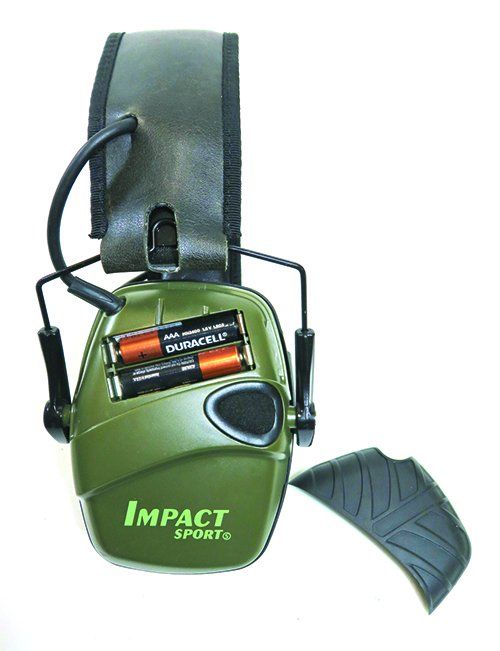
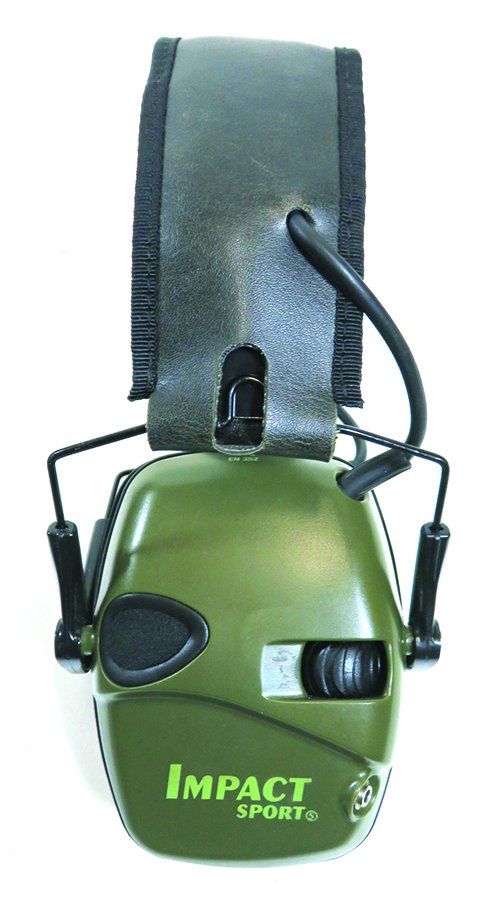
These came from Cabelas.com. Howard Leight Impact Sport earmuffs have a medium-sized ear cup similar to the Walker’s Razor. The ear cups are also tapered, so there was chance a buttstock would knock up against the muff when shouldering a long arm. It has two microphones so you can wear the microphone point to the front or rear. The microphones are covered in foam to reduce wind noise; we like this feature, especially when training outdoors where the wind can blow. The sound clarity with the Impact Sport was good; at high volume there is a hiss. When turning the volume high with all of these earmuffs, you can hear the proverbial pin drop. They really enhance sounds, to the point that you can hear the recoil spring in an AR-15 buffer tube compressing and expanding. The volume-control button on the Howard Leight was large and easy to manipulate. The headband is padded on the inside and has leather on the outside. We found them easy to put on and adjust. The padding in the ear cups was slightly harder than the material on the other earmuffs. This meant the cushion did not seal as well as on the user’s ear compared to the ear cups on the other earmuffs. This was especially prevalent with all of the earmuffs when using eye protection. What we did like about the Howard Leight earmuffs was that the ear-cup cushions can be replaced. None of the other electronic earmuffs have this feature. For about $10 ($9.79; Grainger.com), you can replace worn out ear cushions. No need to trash the earmuffs and buy news ones if the cushion cracks or gets worn out. Also on the upside with the Howard Leight muffs was their compactness. They folded into the smallest package, followed by the Walker’s, Champion, and the largest, Venture Gear. Battery replacement is easy. We also like the auto shut off. One of our testers has had a pair of Howard Leight for years and rarely needs to replace batteries, even though our test team member shoots weekly. We used plugs with the earmuffs when going hot with an AR-15 indoors. We liked the comfort and clarity of these muffs.
Our Team Said: We like the fit and comfort of the Howard Leight earmuffs, the battery life, and the added features like replaceable ear cushions.
GUN TESTS GRADE: A
Champion Ear Muffs Electronic, $31
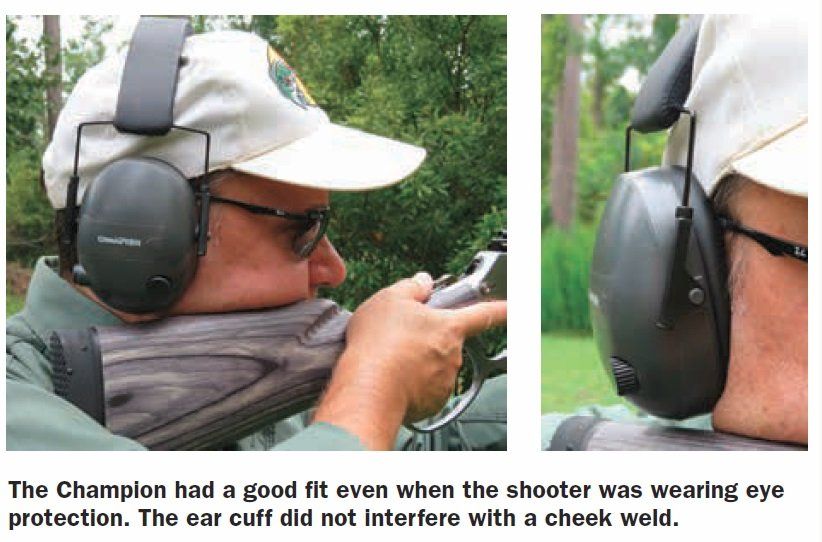
This was a recent price at OpticsPlanet.com. The Champion earmuffs are equipped with two microphones located at one side of the cup so you can wear these to hear the ping on the steel target in front of you or hear what is in back of you, such as a range officer’s command. We don’t mean that you won’t hear either if you swap the way you wear the Champion earmuffs. You will be able to hear relatively clearly. There are also separate volume controls for each ear. We prefer one volume control. The ear cup is small but offered a good fit. Some testers felt the padded head back was a bit tight, and those with big heads also felt like their head was in a C-clamp. This diminished comfort but made sure there was a good seal no matter what type of eye protection the user was wearing. The headband has cloth inside toward the shooter and a synthetic material on the outside is easy to wipe clean.
We noted there was a bit of static when we turned on the Champion earmuffs. The knobs are relatively small and worked well, but we’d prefer larger knobs. There is no auto shut off, so make sure you turn them off after each use and pack extra batteries. We did not have issues with the ear cup interfering with stock weld. It was easy to access the battery compartments to get fresh power.
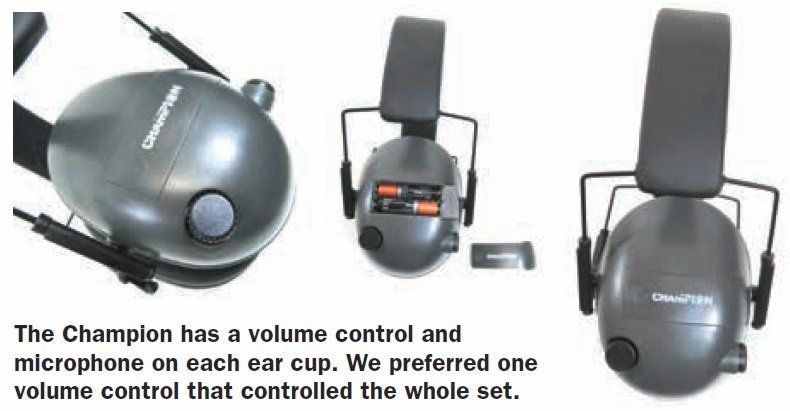
Our Team Said: The Champion earmuffs are an inexpensive option if you can put up with a bit of hiss and static. They are well suited for a shotgun or rifle shooter because you can wear the earmuffs with the microphones pointing away from the muzzle for less noise. We’d recommend using ear plugs in indoor ranges when shooting an AR-15 or magnum revolver.
GUN TESTS GRADE: B
Special thanks to Eastern Outfitters (EasternOutfitter.com) of Hampstead, NC, for its assistance.
Written and photographed by Robert Sadowski, using evaluations from Gun Tests team testers.



























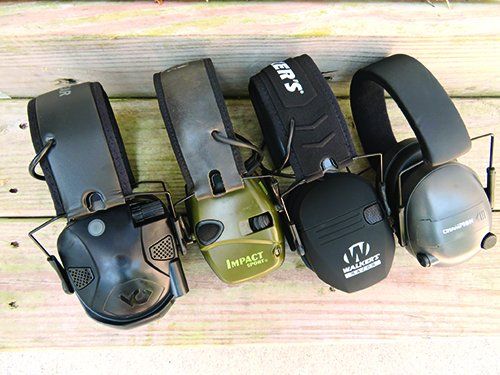

Very interesting article on the electronic earmuffs. You wrote they all passed the ’15dB test’, which is good. I am surprised and a little disappointed that you did not test and rate the amount of decibel reduction that each muff provided. Nor did you state the ‘rated by the manufacturer’ dB reduction amount.
Good information, a little more than anecdotal. Would have been nice to see a chart with the actual decibel reduction of each of these. If they do not do as much as earplugs, then why bother. A chart showing how much decibel reduction in addition when wearing WITH ear plugs would also be nice, or an annotation on the first chart that their decibel reduction would add – 1 for 1 – to the reduction of the ear plugs.
Thanks for the review, but you left out the most important item for most shooters. What was the noise reduction db for each? Even restating what the manufacturer stated would be helpful. Thanks.
The Walker’s Razor Slim does NOT have an auto shut off, possibly a deal-breaker for some.
The Walker Game Ear cushions are replaceable and upgradable. Very easy to replace, they snap off and on. Gel filled upgrade cushions are available ($16). Makes them a heck of a lot more comfortable when wearing glasses. This also provides a better seal around the ears. This upgrade does make the muffs a little wider (affects cheek weld for some shooters). Batteries will last a while if you don’t forget to turn them off. I keep an extra set of rechargeable batteries while at the range. Suggest not folding them up if you use them often. The cables don’t look like they are conductive to lots of flexing over an extended amount of time. Sound clarity is very good. Easy to hear range commands and eavesdrop on others conversations. On windy days you need to adjust the volume down. If you look around you can find them for about $50. Available in different colors. Mine see a lot of use weekly for over 2 yrs. Like ’em a lot.
Oops, meant Walker Razor not Game Ear…
I prefer e-muff with dual volume controls. I’ve had my hearing tested, Right and left ears hear differently, hence the need for right and left volume. I agree with the other comments – it would have been nice to include actual dB or the manufacturers NRR.
Does anyone have a suggestion for someone with a big head. I have a pair of Howard Leight Impact Sport and they are too tight on my head, even extended as far as they can go.
Shooting with regular foam plugs, and would love to be able to take hear what my buddies are saying while shooting. Suggestions please!!